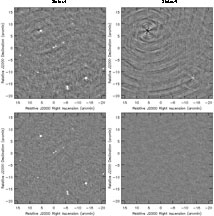Sanjay Bhatnagar

Next generation radio telescopes under construction at NRAO and elsewhere in the world promise at least a ten-fold increase in the achievable sensitivity. Some of the research on imaging and calibration algorithms at NRAO in the past several years has been focused on solving the problem of correcting instrumental and atmospheric effects that vary across the telescope field of view. Unless corrected, these effects are believed to limit the achievable imaging dynamic range of the next generation interferometric radio telescopes. The large numbers of antennas, high data rates, wide fields-of-view (FoV) and high desired dynamic ranges of EVLA and ALMA make it impractical to merely apply old imaging algorithms to reach the scientific goals enabled by the telescope hardware. In the future, the enormous increases in the FoV and number of antennas for the Square Kilometre Array (SKA) make it imperative that we begin to solve these imaging problems now, so that the EVLA/ALMA solutions may be used for guidance in attacking the SKA imaging problem. Our research has lead to the development of a new paradigm and a number of new imaging and calibration algorithms that show promising performance.

Figure 1.The top row shows the full beam Stokes-I and -V image of a field containing two 4C sources located at 75% and 35% response levels of the VLA L-Band beam. No circular polarization signal is expected from this field and all of the power seen in the Stokes-V image is due to instrumental effects. The bottom row shows images made using the new AWProjection algorithm that corrects for the rotation of azimuthally asymmetric antenna beams during image deconvolution. The Stokes-V image is noise-limited, featureless, and corresponds to a dynamic range improvement of a factor of ten. Effects of azimuthal asymmetry of the antenna beams are reduced in the Stokes-I image as well.
 Zoom
Zoom
Instrumental and atmospheric/ionospheric effects generally result in gains that vary with time and across the FoV. While gains that are constant across the FoV may be corrected independent of imaging, correction for direction dependent (DD) effects is difficult and cannot be separated from imaging. Conventional algorithms therefore have been designed to correct only for direction independent effects. Geometric effects which vary across the field of view (W-term), time-varying antenna primary beams (due to rotation of the antenna beam for El-Az mounted antennas, pointing errors, geometrical/gravitational deformations, etc.), and effects of atmospheric/ionospheric gain variations across the FoV are examples of some of the DD effects which will affect EVLA, ALMA and SKA-class telescopes. The combination of higher data rates and computing requirements drives the data processing cost for these next generation telescopes quite high. Therefore, not only is it important to develop new calibration and imaging algorithms to correct for DD effects, it is also important to ensure that the algorithms are computationally efficient and scale well in a parallel computing environment.
Direction dependent effects are fundamentally more complicated to handle than direction independent effects. Until recently, e.g., most attempts to correct for direction-dependent gains due to non-circular antenna beams used direct evaluation of the Fourier integral and were prohibitively slow. In the past few years, we have developed FFT-based fast algorithms to correct for a number of otherwise difficult to correct DD effects that will affect next-generation NRAO telescopes. The WProjection algorithm corrects for the effects of non-coplanar baselines during imaging (Cornwell, Golap and Bhatnagar, EVLA Memo 67, 2003; Special Issue of IEEE JSTSP, Special Issue on Signal Proc. for Astronomical and Space Research Applications, in press). This algorithm is available in the CASA package and has been demonstrated to be faster by a factor of at least ten compared to the conventional image-facet based algorithm. When imaging crowded fields or fields with significant extended emissions, the WProjection algorithm has the added advantage of not splitting the emission across multiple image facets.
Using a model for the antenna aperture function, we also developed an iterative image deconvolution algorithm to correct for the time varying gains of the antenna primary beam that are due to antenna pointing errors and rotation of the primary beam with parallactic angle (Bhatnagar, Cornwell and Golap,EVLA Memo 100, 2006; Bhatnagar, Cornwell, Golap and Uson, A&A 487, 419-429,2008). This algorithm is also available in the CASA package. Full-Stokes, full-beam imaging with the VLA is severely affected by DD time-varying gains due to polarization squint of VLA antennas and rotation of azimuthally asymmetric power pattern with parallactic angle. We used this algorithm for VLA L-Band imaging to demonstrate full-beam Stokes-I and Stokes-V noise-limited imaging capability with an imaging dynamic range improvement of at least an order of magnitude.
Work for accurate measurement of the full-Stokes EVLA antenna power pattern and full-Stokes imaging is in progress. The effects of expected EVLA antenna pointing errors and a pointing selfcal algorithm to efficiently solve for antenna pointing errors has also been developed (Bhatnagar, Cornwell and Golap, EVLA Memo 84, 2004). Work for the implementation and testing of this algorithm for the EVLA and ultimately for mosaicking with ALMA is in progress and in an advanced stage. Work on imaging with wide observing bandwidths and scale-sensitive deconvolution methods for high dynamic range imaging is also in advanced stage. Progress in these and other areas of algorithms research will be reported in future articles.


 Zoom
Zoom